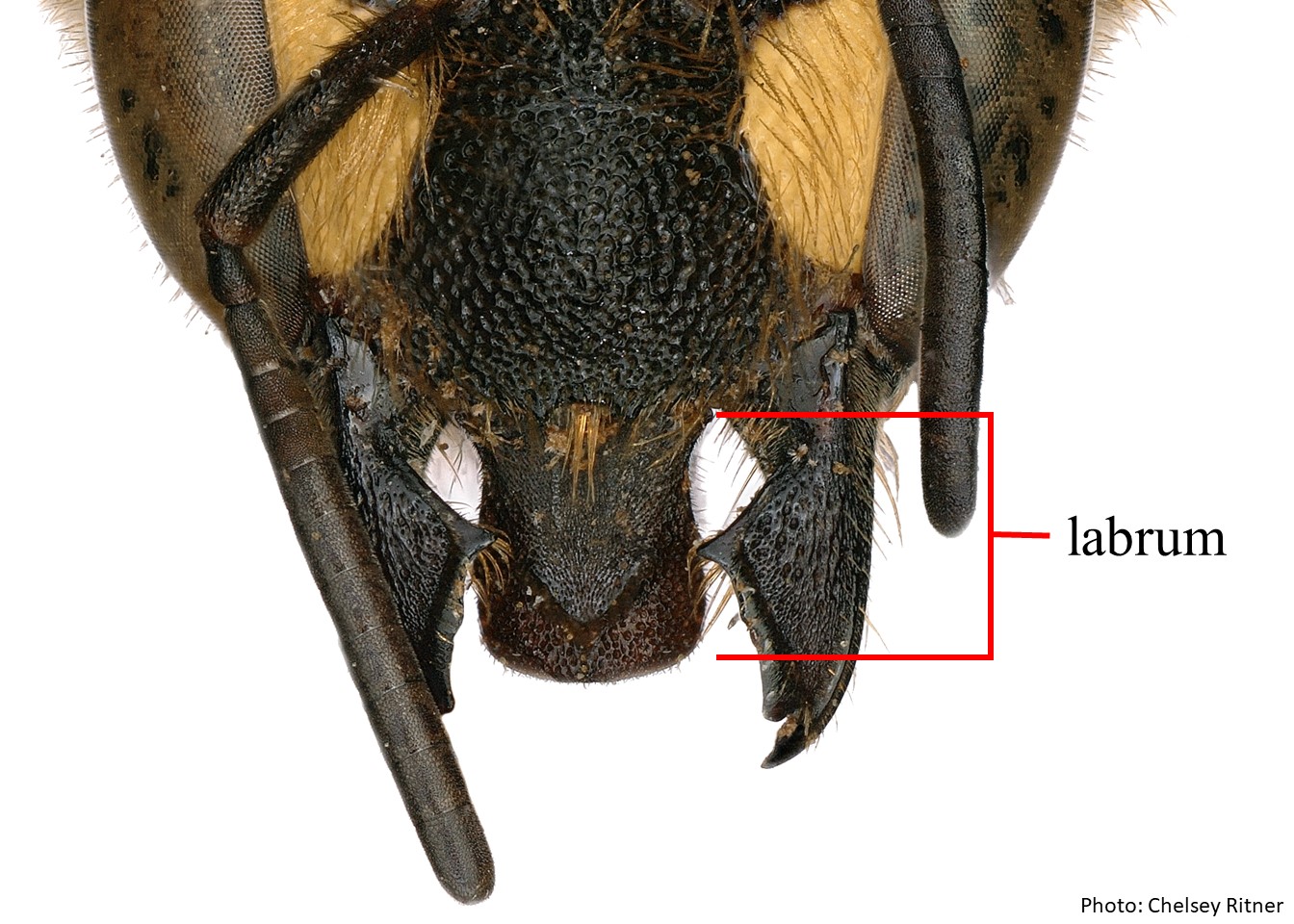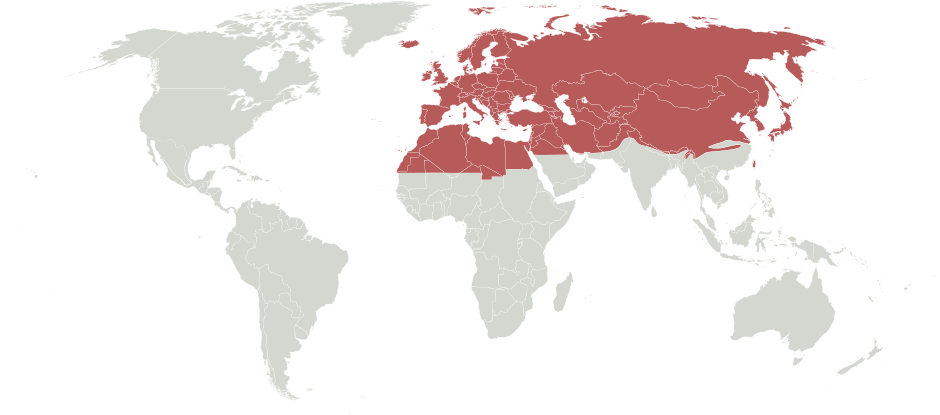Family: Megachilidae
Subfamily: Megachilinae
Tribe: Dioxyini
Genus: Dioxys Lepeletier & Serville, 1825
Subgenera: none
Common name: cuckoo bees
Dioxys are black bees with white apicalapical:
near or at the apex or end of any structure
bands on the tergaterga:
the segments on the top side of the abdomen, often abbreviated when referring to a specific segment to T1, T2, T3, T4, T5, T6, or T7 that range in body length from 6–12 mm (Michener 2007Michener 2007:
that range in body length from 6–12 mm (Michener 2007Michener 2007:
Michener, C.D. 2007. The Bees of the World (2nd ed.). Johns Hopkins University Press, Baltimore and London, 953 pp.). Dioxys are cleptoparasiticcleptoparasitic:
bees that lay their eggs in the nest cells of bees in other genera. Their larvae depend on the pollen provided by their host. Since cleptoparasitic bees don't provision their own nests, and instead depend on the pollen collected by their host, the females lack pollen collecting hairs. This often gives them a wasp-like appearance.
bees, and the females lack scopascopa:
modified hairs for carrying pollen; often branched and dense hairs on the hind-leg, or on the ventral surface of the abdomen in Megachilidae
because they do not gather pollen (Michener 2007Michener 2007:
Michener, C.D. 2007. The Bees of the World (2nd ed.). Johns Hopkins University Press, Baltimore and London, 953 pp.). They also have a noticeably pointed abdomen (Wilson and Carril 2016Wilson and Carril 2016:
Wilson, J.S. and O.M. Carril. 2016. The Bees in Your Backyard: A Guide to North Americarsquo;s Bees. Princeton University Press, Princeton and Oxford, 288 pp.). The narrowed body shape, coloration, and reduced setaesetae:
a still hair-like structure or bristle
give them a slightly “waspy” appearance, like many other cleptoparasiticcleptoparasitic:
bees that lay their eggs in the nest cells of bees in other genera. Their larvae depend on the pollen provided by their host. Since cleptoparasitic bees don't provision their own nests, and instead depend on the pollen collected by their host, the females lack pollen collecting hairs. This often gives them a wasp-like appearance.
bees.
Dioxys contains 15 species worldwide; 5 of which occur in the U.S. and Canada (Michener 2007Michener 2007:
Michener, C.D. 2007. The Bees of the World (2nd ed.). Johns Hopkins University Press, Baltimore and London, 953 pp.).
(modified from Michener 2007Michener 2007:
Michener, C.D. 2007. The Bees of the World (2nd ed.). Johns Hopkins University Press, Baltimore and London, 953 pp.)
 elongate without transverse basalbasal:
elongate without transverse basalbasal: carinatecarinate:
carinatecarinate: broad, not or only slightly exceeding T6T6:
broad, not or only slightly exceeding T6T6: .
.Dioxys is similar in appearance to the other Dioxyini, but can be distinguished by the combination of characters above (Michener 2007Michener 2007:
Michener, C.D. 2007. The Bees of the World (2nd ed.). Johns Hopkins University Press, Baltimore and London, 953 pp.).
There are no known invasives.
Dioxys are cleptoparasiticcleptoparasitic:
bees that lay their eggs in the nest cells of bees in other genera. Their larvae depend on the pollen provided by their host. Since cleptoparasitic bees don't provision their own nests, and instead depend on the pollen collected by their host, the females lack pollen collecting hairs. This often gives them a wasp-like appearance.
bees, and females do not gather pollen from flowers since the larvaelarvae:
active immature form of an insect, especially one that differs greatly from the adult and forms the stage between egg and pupa
develop parasitically on their host’s pollen provisions (Michener 2007Michener 2007:
Michener, C.D. 2007. The Bees of the World (2nd ed.). Johns Hopkins University Press, Baltimore and London, 953 pp.). They will, however visit a wide variety of flowers for nectar. Dioxys are known to parasitize bees in several different genera within the Megachilinae subfamily (Hurd 1958Hurd 1958:
Hurd, P.D, Jr. 1958. The American bees of the genus Dioxys Lepeletier and Serville (Hymenoptera: Megachilidae). University of California Publications in Entomology 14: 275ndash;302). Dioxys aurifuscus has been observed in the nests of Anthidium (Cockerell 1909Cockerell 1909:
Cockerell, T.D.A. 1909. Some new bees and other notes. The Canadian Entomologist 41: 128ndash;131.; Hicks 1929Hicks 1929:
Hicks, C.H. 1929. On the nesting habits of Callanthidium illustre (Cresson). The Canadian Entomologist 61: 1ndash;8.). Dioxys pomonae has been associated with Anthidium, Megachile, and Osmia (Hurd 1958Hurd 1958:
Hurd, P.D, Jr. 1958. The American bees of the genus Dioxys Lepeletier and Serville (Hymenoptera: Megachilidae). University of California Publications in Entomology 14: 275ndash;302). Dioxys producta is also a parasite of multiple species of Anthidium (Hurd 1958Hurd 1958:
Hurd, P.D, Jr. 1958. The American bees of the genus Dioxys Lepeletier and Serville (Hymenoptera: Megachilidae). University of California Publications in Entomology 14: 275ndash;302).
Dioxys are one of the various groups of solitary brood parasites collectively referred to as “cuckoo bees” and are cleptoparasiticcleptoparasitic:
bees that lay their eggs in the nest cells of bees in other genera. Their larvae depend on the pollen provided by their host. Since cleptoparasitic bees don't provision their own nests, and instead depend on the pollen collected by their host, the females lack pollen collecting hairs. This often gives them a wasp-like appearance.
on other megachilid bees. They prefer parasitizing Anthidium, Megachile, and Osmia nests, although the boundaries of host selection within these groups are little understood (Michener 2007Michener 2007:
Michener, C.D. 2007. The Bees of the World (2nd ed.). Johns Hopkins University Press, Baltimore and London, 953 pp.). The female parasite often spends time around the preferred floral resources of its host to locate them. Once a host nest is found, an egg is laid inside a cell as it is being provisioned by the host female (Rozen and Favreau 1967Rozen and Favreau 1967:
Rozen Jr. J.G. and M.S. Favreau. 1967. Biological notes on Dioxys pomonae pomonae and on its host, Osmia nigrobarbata (Hymenoptera: Megachilidae). Journal of the New York Entomological Society 75: 197ndash;203.), or it is injected into the cell after it has been sealed off (Rozen and Özbek 2005). Unlike most bee larvaelarvae:
active immature form of an insect, especially one that differs greatly from the adult and forms the stage between egg and pupa
, they are active after hatching from the egg. They have pointed mandibles that are used to destroy the host egg or larvalarva:
active immature form of an insect, especially one that differs greatly from the adult and forms the stage between egg and pupa
(Rozen and Özbek 2004). The larvalarva:
active immature form of an insect, especially one that differs greatly from the adult and forms the stage between egg and pupa
retains the somewhat modified “ hospicidalhospicidal:
the early instars of clepoparasitic bees, which have been oviposited into complete brood cells of another species. When the early instars develop, they kill off the developing individual that was originally occupying the brood cell.
” body form for multiple instars before molting into a more ordinary grub-like form where it feeds on the pollen stores of its host (Rozen and Özbek 2004).
Dioxys has a wide distribution in the PalearcticPalearctic:
the largest biogeographic region; consists of Europe, Asia north of the Himalaya foothills, Northern Africa, and the northern and central parts of the Arabian Peninsula as well as North America, where Dioxys occupies much of the western U.S. (Michener 2007Michener 2007:
as well as North America, where Dioxys occupies much of the western U.S. (Michener 2007Michener 2007:
Michener, C.D. 2007. The Bees of the World (2nd ed.). Johns Hopkins University Press, Baltimore and London, 953 pp.).
Distribution map generated by Discover Life -- click on map for details, credits, and terms of use.
Cockerell, T.D.A. 1909. Some new bees and other notes. The Canadian Entomologist 41: 128-131.
Hicks, C.H. 1929. On the nesting habits of Callanthidium illustre (Cresson). The Canadian Entomologist 61: 1-8.
Hurd, P.D, Jr. 1958. The American bees of the genus Dioxys Lepeletier and Serville (Hymenoptera: Megachilidae). University of California Publications in Entomology 14: 275-302
Michener, C.D. 2007. The Bees of the World (2nd ed.). Johns Hopkins University Press, Baltimore and London, 953 pp.
Rozen Jr. J.G. and M.S. Favreau. 1967. Biological notes on Dioxys pomonae pomonae and on its host, Osmia nigrobarbata (Hymenoptera: Megachilidae). Journal of the New York Entomological Society 75: 197-203.
Rozen Jr., J.G. and H. Özbek. 2004. Immature stages of the cleptoparasiticcleptoparasitic:
bees that lay their eggs in the nest cells of bees in other genera. Their larvae depend on the pollen provided by their host. Since cleptoparasitic bees don't provision their own nests, and instead depend on the pollen collected by their host, the females lack pollen collecting hairs. This often gives them a wasp-like appearance.
bee Dioxys cincta (Apoidea: Megachilidae: Megachilinae: Dioxyini). American Museum Novitates 3443:1-12.
Rozen Jr. J.G. and H. Özbek. 2005. Egg deposition of the cleptoparasiticcleptoparasitic:
bees that lay their eggs in the nest cells of bees in other genera. Their larvae depend on the pollen provided by their host. Since cleptoparasitic bees don't provision their own nests, and instead depend on the pollen collected by their host, the females lack pollen collecting hairs. This often gives them a wasp-like appearance.
bee Dioxys cincta (Hymenoptera: Apoidea: Megachilidae). Journal of the Kansas Entomological Society 78: 221-226.
Wilson, J.S. and O.M. Carril. 2016. The Bees in Your Backyard: A Guide to North America’s Bees. Princeton University Press, Princeton and Oxford, 288 pp.